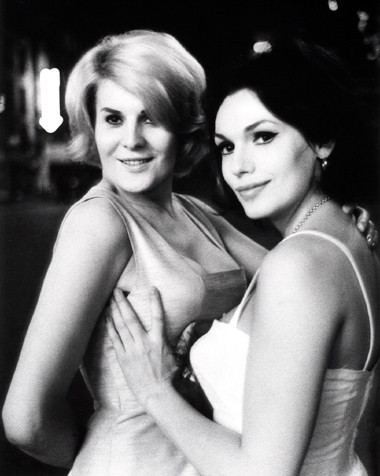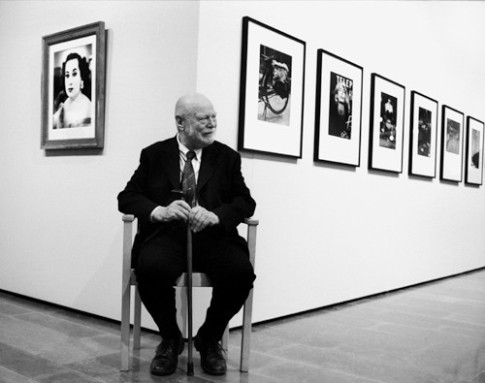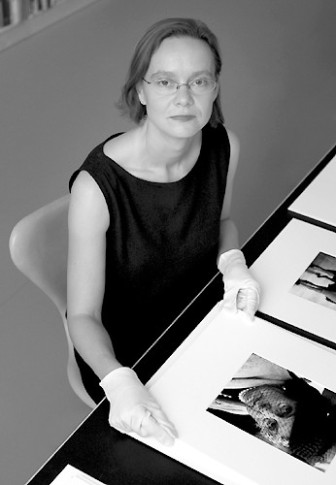Diane Arbus Biography
Thanks to two Guggenheim grants, in 1963 and 1966, she was able to undertake two independent projects and travelled around the USA for two summers, taking pictures on the theme of American rituals. It is on these journeys some of her most famous portraits of people in more or less unusual situations and environments were taken. Her life ended abruptly with suicide in 1971. The following year, The Museum of Modern Art in New York had a posthumous exhibition of her work, making her one of the most well-known postwar photographers.
”I never have taken a picture I´ve intended. They’re always better or worse” Diane Arbus, from ”Diane Arbus. An Aperture Monograph”, Aperture, New York, 1972, 15.
1923
Diane Nemerov was born on 14 March in New York, USA, and grew up in a Jewish family. Her father, David Nemerov, was a partner and head of purchasing at Russek’s, a department store in New York.
1928
Enrolled at the Ethical Culture School in New York. The private school is renowned for its intellectual openness and its focus on humanistic and social values. Her older brother, the writer and poet Howard Nemerov (b. 1920), attended the same school, eventually followed by her sister Renée Sparkia (b. 1928), sculptor.
1934
Continued her studies at the Ethical Culture Fieldston School.
1940
Graduated in June.
1941
Married Allan Arbus (b. 1918), who worked in the advertising department of Russek’s. Was given Graflex 2 ¼² x 3 ¼² camera by Allan Arbus. Attended a course in photography that concentrated on technical aspects, held by the photographer Berenice Abbot.
1945
The Arbus’s first daughter, Doon, was born. At the time, Allan Arbus was in Burma, conscripted during the Second World War. While in the army he received training as a photographer.
1946
After Allan Arbus returned from the army, the couple began working together on fashion and advertising. Diane Arbus was responsible for the concept and her husband took the photographs. Their popularity gradually earned them assignments for magazines such as Seventeen, Glamour and Vogue.
1951
The couple rented out their studio for a year and went to Paris with their daughter. Spent the spring and summer in Paris and made short trips to Bourgogne, Versailles and Bretagne. They also travelled around Spain for a few weeks. In September they left Paris for Italy.
1954
Amy Arbus, their second daughter was born.
1955
Began studying photography under Alexey Brodovitch, art director of Harper’s Bazaar, at the New School for Social Research in New York. Diane and Allan Arbus contributed a photograph to Edward Steichen’s exhibition The Family of Man at The Museum of Modern Art, New York.
1956
Left the Arbus studio and embarked on a solo career. Allan Arbus continued to operate the studio, and also began a career as an actor. Diane Arbus started a two-year course in photography with Lisette Model as her teacher. This was the beginning of a close friendship between the two.
1958
Separated from Allan Arbus and moved into her own flat in New York together with her two daughters.
1960
Contacted the art director of Esquire. Six of her photographs and her first photo essay were published in the July issue of Esquire, under the title “The Vertical Journey: Six Movements of a Moment Within the Heart of the City”.
1961
Harper’s Bazaar published six of her portraits, under the title “The Full Circle”, with her own written comments accompanying each picture.
1962
Went on a coach tour around the USA, with Los Angeles as her final destination. She stayed in Los Angeles for about a month, working on various projects.
1963
Won her first Guggenheim grant for the project “American Rites, Manners and Customs”. Visited Sunshine Park, a nudist camp in New Jersey and took photographs.
1964
In the course of the year, she visited several places, including New Orleans in February and California in August, where she stayed for approximately one month. Worked simultaneously on several magazine assignments and private projects. The Museum of Modern Art, New York, bought six of her works. Diane Arbus donated an additional work to the collection.
1965
Started teaching a photography class at Parson’s School of Design, New York, in the autumn. Participated in a group exhibition, Recent Acquisitions: Photography, at the Museum of Modern Art in New York. John Szarkowski, head of the photography department, featured three of her portraits in the exhibition.
1966
Received a second grant from the Guggenheim Foundation. Travelled around the USA; a short trip to Miami in Florida, and later in the year to San Francisco and southern California. A few of her photographs from “American Rites, Manners and Customs” were exhibited at the Philadelphia College of Art, together with other Guggenheim photographers who had received grants from 1937 to 1965.
1967
Her major breakthrough was with the exhibition New Documents: Photographs by Diane Arbus, Lee Friedlander; and Garry Winogrand at the Museum of Modern Art in New York. Out of the three Arbus received the most attention from the press – including The New York Times and Newsweek – and 32 of her works were shown in a separate gallery in the museum.
1968
Resumed teaching; now at the Cooper’s Union in New York.
1969
Diane and Allan Arbus divorced. Allan Arbus moved to California to pursue his acting career. Ten of her photographs were included in the Museum of Modern Art’s touring exhibition New Photography U.S.A.
1970
Taught at the Rhode Island School of Design during the spring semester.
1971
Taught a master class in photography in her home in Westbeth. Compiled a portfolio of ten signed photographs: “A Box of Ten Photographs”. Her friend Marvin Israel designed the box. The photograph A boy with a straw hat waiting to march in a pro-war parade, N.Y.C. 1967 was published on the May cover of Artforum. Five of the remaining nine photographs in the portfolio were published in the magazine. Committed suicide on 26 July, at the age of 48.
1972
The year after she died, the Museum of Modern Art, New York, honoured her with a major retrospective. The exhibition toured the USA, Canada, Japan, Australia and New Zealand until 1979. By that time, it had been shown at 43 museums and galleries, and had been seen by more than 250,000 people. The same year, she was the first American photographer ever to have been exhibited at the Venice Biennale.
1984
The exhibition Diane Arbus: Magazine Work, 1960-1971 was shown at the Spencer Museum of Art in Kansas before touring the USA.
2003
The exhibition Diane Arbus Revelations was shown at the San Francisco Museum of Modern Art. It featured a selection that spanned from her less well-known works from the 1940s to her famous images from the 1960s. The exhibition has been touring in the USA and Europe.
Diane Arbus, 1970. The Rhode Island School of Design. Photo: Stephen Frank © Smithsonian Institution, Courtesy, National Portrait Gallery



